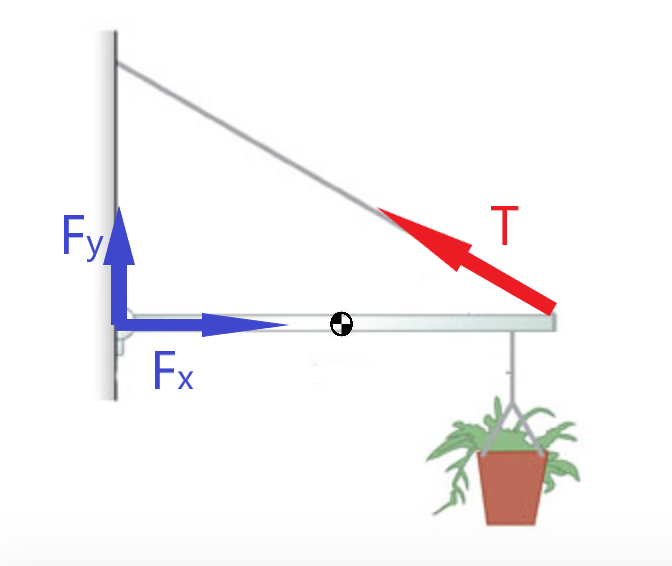The plant in the picture has mass of 29 kg, and is hanging at a distance of 1.4 meters from the wall. The horizontal rod has mass of 6.2 kg. Assume that its weight is evenly distributed, therefore it can be treated as a single force at the center of mass. The rod is 2 meters long, and there is a cable at a 23° angle supporting it at the end. Center of mass of rod from the point = 2/2=1m Using the wall as the axis of rotation, find the magnitude of the downward torque, from both the weight of the rod and the weight of the plant. t=458.64Nm a.The downward torque is balanced by the upward torque from the force of tension. Find the magnitude of the force of tension. T=?N b.F is the contact force between the rod and the wall. Using the other horizontal force in the problem, find the horizontal component of F (the normal force) that must be present for the rod to be at equilibrium. Fx=?N c.There is a vertical force from a component of the tension, but this is not enough to balance the donward forces. Find the vertical force that must be present for the wall to keep the rod up. Fy=?N
The plant in the picture has mass of 29 kg, and is hanging at a distance of 1.4 meters from the wall. The horizontal rod has mass of 6.2 kg. Assume that its weight is evenly distributed, therefore it can be treated as a single force at the center of mass. The rod is 2 meters long, and there is a cable at a 23° angle supporting it at the end.
Center of mass of rod from the point = 2/2=1m
Using the wall as the axis of rotation, find the magnitude of the downward torque, from both the weight of the rod and the weight of the plant. t=458.64Nm
a.The downward torque is balanced by the upward torque from the force of tension. Find the magnitude of the force of tension. T=?N
b.F is the contact force between the rod and the wall. Using the other horizontal force in the problem, find the horizontal component of F (the normal force) that must be present for the rod to be at equilibrium. Fx=?N
c.There is a vertical force from a component of the tension, but this is not enough to balance the donward forces. Find the vertical force that must be present for the wall to keep the rod up. Fy=?N

Trending now
This is a popular solution!
Step by step
Solved in 2 steps with 1 images









